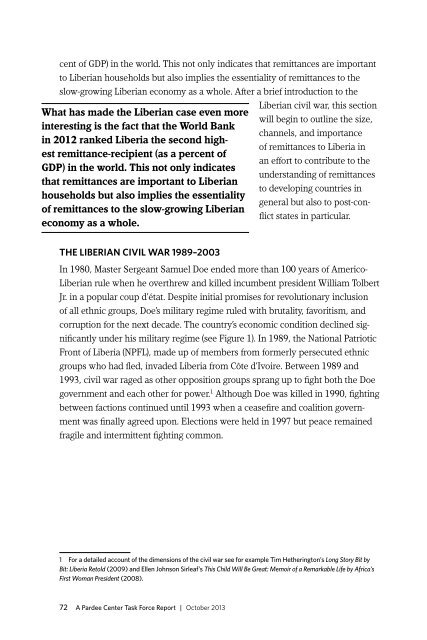Pardee-CFLP-Remittances-TF-Report
Pardee-CFLP-Remittances-TF-Report
Pardee-CFLP-Remittances-TF-Report
You also want an ePaper? Increase the reach of your titles
YUMPU automatically turns print PDFs into web optimized ePapers that Google loves.
cent of GDP) in the world. This not only indicates that remittances are importantto Liberian households but also implies the essentiality of remittances to theslow-growing Liberian economy as a whole. After a brief introduction to theWhat has made the Liberian case even moreinteresting is the fact that the World Bankin 2012 ranked Liberia the second highestremittance-recipient (as a percent ofGDP) in the world. This not only indicatesthat remittances are important to Liberianhouseholds but also implies the essentialityof remittances to the slow-growing Liberianeconomy as a whole.Liberian civil war, this sectionwill begin to outline the size,channels, and importanceof remittances to Liberia inan effort to contribute to theunderstanding of remittancesto developing countries ingeneral but also to post-conflictstates in particular.The Liberian Civil War 1989–2003In 1980, Master Sergeant Samuel Doe ended more than 100 years of Americo-Liberian rule when he overthrew and killed incumbent president William TolbertJr. in a popular coup d’état. Despite initial promises for revolutionary inclusionof all ethnic groups, Doe’s military regime ruled with brutality, favoritism, andcorruption for the next decade. The country’s economic condition declined significantlyunder his military regime (see Figure 1). In 1989, the National PatrioticFront of Liberia (NPFL), made up of members from formerly persecuted ethnicgroups who had fled, invaded Liberia from Côte d’Ivoire. Between 1989 and1993, civil war raged as other opposition groups sprang up to fight both the Doegovernment and each other for power. 1 Although Doe was killed in 1990, fightingbetween factions continued until 1993 when a ceasefire and coalition governmentwas finally agreed upon. Elections were held in 1997 but peace remainedfragile and intermittent fighting common.1 For a detailed account of the dimensions of the civil war see for example Tim Hetherington’s Long Story Bit byBit: Liberia Retold (2009) and Ellen Johnson Sirleaf’s This Child Will Be Great: Memoir of a Remarkable Life by Africa’sFirst Woman President (2008).72 A <strong>Pardee</strong> Center Task Force <strong>Report</strong> | October 2013


